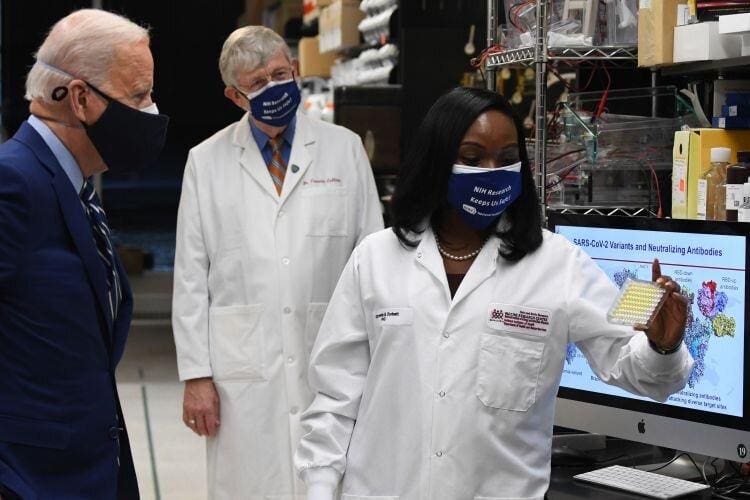The National Institutes of Health (NIH) is the fuel that feeds the American engine of medical discovery and the linchpin to our country’s post-COVID economic recovery.

President Biden listens to Dr. Kizzmekia S. Corbett (right) as he tours the Viral Pathogenesis Laboratory at the National Institutes of Health (NIH). The NIH is “the very fuel that feeds the American engine of medical discovery and the linchpin to our country’s post-COVID economic recovery,” writes Dr. Gary K. Michelson. SAUL LOEB—AFP/GETTY IMAGES
By Gary K. Michelson, M.D.
This article was published by Fortune.com
Thanks to the availability of COVID-19 vaccines, fostered by unprecedented government investment in high-risk vaccine research, we are starting to see the shaky semblance of an end to the worst of the pandemic—a pandemic that is estimated will cost the U.S. $16 trillion.
Now is the time to vaccinate the economy and bolster our ability to respond to tomorrow’s emerging public health threats by investing heavily in biomedical research with its transformative potential.
The National Institutes of Health (NIH) is the world’s single largest funder of medical research, the very fuel that feeds the American engine of medical discovery and the linchpin to our country’s post-COVID economic recovery.
The Biden administration is proposing to fund the NIH at $52 billion in 2022, a 21% increase over the current level. It’s a good start, but not nearly enough.
At a minimum, the NIH budget needs to be more than doubled, to $100 billion. Today. This is the actual national defense we need. It is not hyperbole.

The question is, “Shall we continue with business as usual, or step up to invest in our future?” – Dr. Gary Michelson
Just one NIH-funded medical research program, the Human Genome Project, has directly generated more than a trillion dollars for the U.S. economy—a 178-fold return on investment. From 1988 to 2012, these returns included $54.8 billion in tax revenues from sectors associated with genomics, including instruments, diagnostics, and pharmaceutical research and development (R&D), and more than 4.3 million job-years of employment for individuals in these sectors. The opportunity and impact continue to grow.
Beyond genomics, NIH-funded research has been instrumental in enabling people to live longer and healthier lives. Because of NIH-funded research, infections like HIV/AIDS and meningitis can be prevented and treated; heart disease, stroke, and diabetes are less deadly; and people live longer and with greater well-being than at any time in history. A recent study found that taxpayer-supported NIH funding contributed to the development of all 210 drugs approved by the Food and Drug Administration (FDA) between 2010 and 2016—every single one.
But perhaps the NIH’s greatest success story is the one we are experiencing right now. The unprecedented development of multiple COVID-19 vaccines in less than one year is a direct result of decades of investment in fundamental biomedical research in genetics, infectious disease, and cardiovascular and pulmonary health. Without the NIH, our nation and the world would have had no chance against the COVID-19 pandemic.
The NIH is so successful in part because of the robust biomedical research ecosystem that it anchors. NIH-funded research is conducted at universities, nonprofit research institutions, and private companies. NIH funds the best and most promising science by making grants to those researchers with the best ideas, as judged by their peers. The NIH’s peer review system for determining which science should be funded is the world’s gold standard for managing investments in scientific research. Even so, the NIH has only had the resources to fund one out of every five medical researchers who applied, and consistently at an amount less than they requested.
The Michelson Medical Research Foundation—along with with many other philanthropic organizations—invests in high-quality, cutting-edge scientific research because a single breakthrough could benefit the lives and health of hundreds of millions—if not billions—of people.
But we cannot do it alone. Truly transformational advances need to be seeded by robust public investment. Such an investment has already proven to have exponential returns to the economy, jobs, tax revenues, and—most importantly—humankind.
Following the record-shattering success of the COVID-19 vaccine development program, and with an administration that is strongly supportive of research, we are at an inflection point.
Now is precisely the time to be bold and go big. It is time for the NIH to invest in what has been off-limits: high-risk, high-return research with the highest potential for scientific breakthroughs. Programs like The Common Fund that support this kind of research—research that could lead to vaccines for common cancers, drug delivery targeted to specific organs or tissue types, and more—represent only 1.5% of the agency’s budget.
The question is, “Shall we continue with business as usual, or step up to invest in our future?”
We have a once-in-a-lifetime opportunity, and obligation, to pave the way for medical advances to benefit all of us.
Let’s seize it.
Gary K. Michelson, MD, is the founder and co-chair of the Michelson Medical Research Foundation and the Michelson Prizes, annual awards presented to young investigators who are advancing human immunology, vaccine discovery, and immunotherapy research. He and his wife, Alya, are members of The Giving Pledge.

